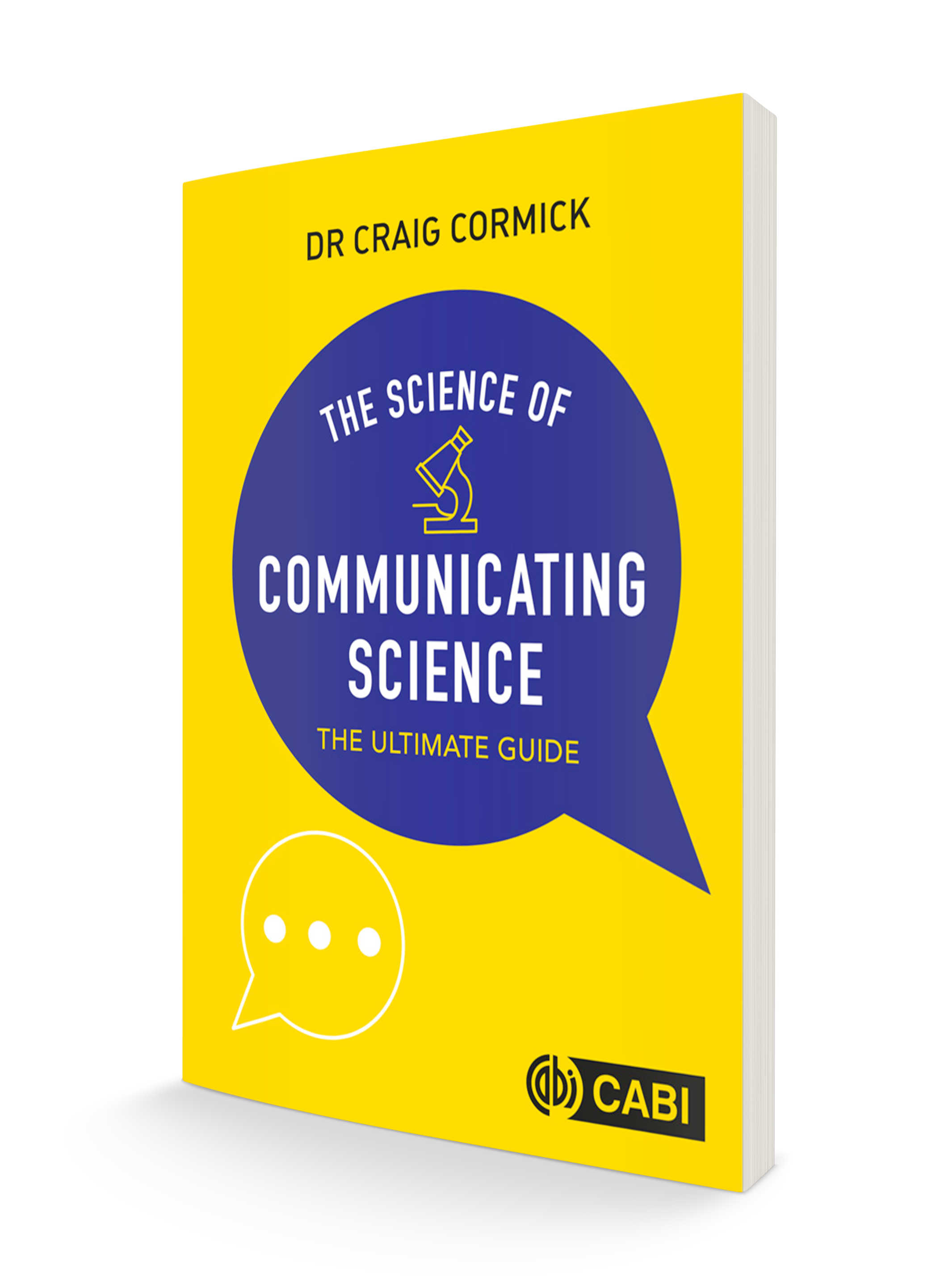By Rachel Winks, CABI
The Science of Communicating Science: The Ultimate Guide by Dr Craig Cormick, published this month jointly by CABI and CSIRO, is a book that helps to solve a major problem that many scientists face at some point in their career: how do I communicate my work to society?
How do I give that interview with a news outlet that would help explain my research to the general public, or how do I deliver that presentation to a donor that could secure the next round of funding for my project?

While there are millions of chatty blogs, books and videos about how to talk to the press or give a speech, where do scientists go to get digestible but evidence-based answers about the approaches that work best; the tools that really move the dial?
The answer is: The Science of Communicating Science. This is a rare book that combines academic rigour with the ease of reading a blog. This ultimate guide is a solid one-stop-shop where scientists can learn about the main aspects of science communication without – as the blurb says – “having to read several hundred academic papers and blogs and books.”
Dr Cormick explains the aim of the book is to “distil the breadth of good research that is out there into an easy to understand format.” He says, “In lieu of reading hundreds of research papers, you could read a single book like this that tries to summarise the best of them, and tries to give a plain English explanation of what is known, and how you can use what we know to better communicate science.”

Cormick C (2014) ‘Community attitudes towards science and technology in Australia’. CSIRO, Canberra
The book achieves its goal.
The strength of this ultimate guide is that it forces you to think about why you’re doing communications at all. This is important, as in our fast-paced society it’s easy to feel the pressure to quickly start communications projects and produce outputs, diving into Twitter and YouTube accounts, without first taking the time to think about the outcomes that you want to achieve. This book gives context so that you know why you’re embarking on science communication and delivers insights so that you create the best chances for being impactful.
Science communication research is “largely published in places and in languages that scientists don’t visit and don’t really understand”
The book also helps to solve an unusual problem surrounding science communication: the disconnect between scientists and the information available on science communication. In the introduction Dr Cormick quotes Professor Brigitte Nerlich of Nottingham University who talks about the proliferation of science communication research, but states: “Unfortunately, the results of that research are largely published in places and in languages that scientists don’t visit and don’t really understand. As a result, there is some estrangement between those who still communicate and those who want to tell them how to do it.”
This book brings the science community together with the science communication research.
In terms of tone, this is an entertaining and readable book. Dr Cormick likes to tell a story, so as you read you’re seeing how narrative and fact-based information can be delivered side-by-side. The book offers some lightbulb ‘ah-ha’ moments, for example, around news (so that’s why certain stories make the papers) that help you feel like you’re glancing into what can often be a mysterious and opaque industry to many scientists.

Case studies and text boxes help to highlight key ideas throughout the book
The book has a four part structure that creates a comprehensive but digestible road map for science communications.
Part 1: The ground rules
This is an important section. It lays out facts and truths that are essential to understand before wading into setting up Facebook accounts or drafting press releases. This section covers the importance of observing and understanding your audience, audience segmentation, creating SMART goals – even when the temptation might be to dive into creating an explosive, viral YouTube video.
Part 2: Communication tools
This is the main section of the book and includes practical advice about specific communication tools. Its introduction helpfully explains the importance of simple messaging (not dumbing down) and tools like the message box and half-life messages, and the power of metaphors.
 It includes a nice long chapter on the media – the changing nature and ‘truths’ of the media, practical tips on writing media releases and working with the media – and another chapter on social media. This is helpful as these two tools seem to be the ones most scientists have hesitations or reservations about, but are the ones they are most often pulled towards.
It includes a nice long chapter on the media – the changing nature and ‘truths’ of the media, practical tips on writing media releases and working with the media – and another chapter on social media. This is helpful as these two tools seem to be the ones most scientists have hesitations or reservations about, but are the ones they are most often pulled towards.
Storytelling is a particularly useful chapter, covering things like the power of the narrative to lift your work out of the crowd, the ‘and, but, therefore’ (ABT) structure, writing style tips and building trust with your audience. Two particularly useful chapters cover framing (the angle or lens through which you tell stories) and policy or politics communications (important for scientists communicating for funding), which are areas that are often overlooked in books about communications.
Part 3: When things get hard
This is one of the most interesting parts of the book, since it tackles exactly those times that scientists dread the most: what to do when things get hard. In a world of fake news, can you really change behaviours and opinions? How do you share data and evidence that compete with beliefs and values?
Part 4: Science communication issues
The final section of the book includes some thought provoking issues, including ethics – essential for those wanting to communicate science faithfully and objectively while understanding that opinions and personality are often an important element of communication.
Throughout the book are interesting and relevant case studies. The end of each chapter includes a section entitled ‘What to do with what you now know’, which offers practical steps for taking action, as well as ‘Key summary points’ to capture the highlights of each chapter. There are also excellent endnotes for further reading. The charts, illustrations and tables enhance the book’s messages.
As the blurb states, this book would be suitable for “anyone who is interested in science communication and all scientists wishing to improve their own communication techniques.” But given its scientific basis, it would be a good read for anyone with a technical background too. Dr Cormick often mentions biologists, chemists and physicists, but engineers and software developers who find themselves needing to communicate complex ideas to general audiences – possibly even customers – would benefit from this book as well. Those already working in science communications, such as marketing and PR, can also benefit from this book.
Dr Cormick is, of course, a science communicator himself with over 25 years of experience. He’s worked with organisations such as CSIRO, Questacon and the Department of Industry, Innovation and Science. As his biography mentions:
“He has been widely published on science communication issues in key journals and the popular media, including ABC Radio National’s The Science Show, the Conversation, and has twice appeared in Best Australian Science Writing. He is a popular speaker on science communication issues at conferences in Australia and overseas. In 2013, he was awarded the Unsung Hero of Science Communication by the Australian Science Communicators (ASC) and is currently the President of the ASC.”
Interestingly, he is both a science communicator and a writer of fiction – a storyteller. The chatty, humorous way in which he writes makes this an easy book to read, while he keeps his eye clearly on the science audience for which this book is intended.
In sum, for any scientist needing to communicate their work, this book will be a thoroughly helpful resource.

The Science of Communicating Science, by Craig Cormick, is published by CABI and available from the CABI Bookshop.
1 Comment
Leave a Reply

A very useful book . Can i get pdf version on line for reading